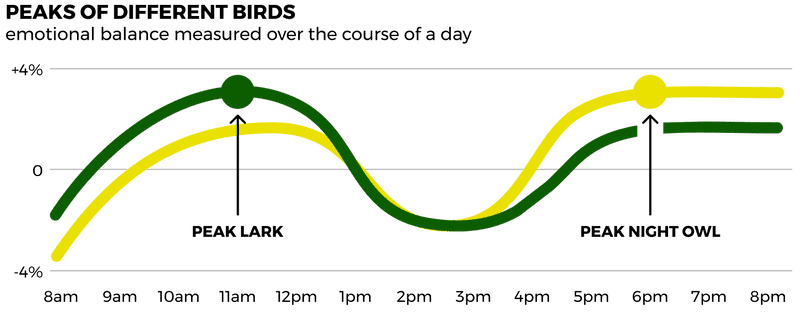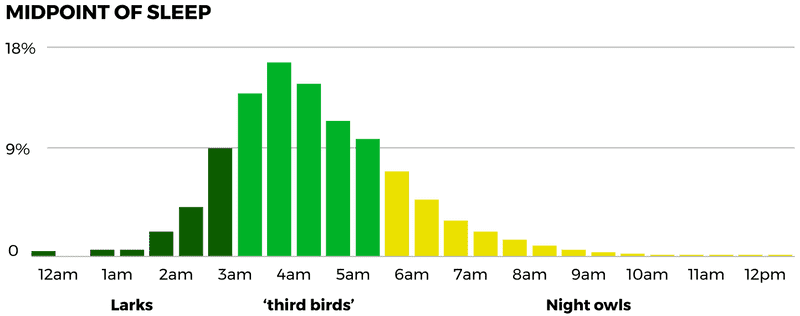Regardless of how you performed at school or work in the past, it's likely that you could have done better. Most of us have felt that way, often blaming our shortfalls on a lack of effort when our chronotype - or internal clock - is likely playing a much larger role.
Where you were born or what you do professionally matters little to the chronotype that our bodies adhere to.
While you may have heard of night owls and larks before, there is a science behind those terms and discovering how to align your day with your chronotype can pay significant benefits.
A flock behind your clock
Before digging into the advantages and disadvantages associated with chronotypes, you first need to discover what your actual chronotype is. Start by taking the Automated Morningness-Eveningness Questionnaire (AutoMEQ) which will provide you with valuable feedback that will help determine if you are a night owl, lark (morning person), or what author Daniel Pink designates a 'third bird.' The good news is that once you identify your chronotype, you can begin to use the insight to calibrate your day better and take steps to offset any collisions between your internal clock and societal norms.
The research highlighted by Pink in his book When: The Scientific Secrets of Perfect Timing indicates that most of us reside as some variety of third bird, as seen above, never quite reaching the smaller clusters of larks or night owls that reside at the ends of the spectrum.
An interesting aspect of chronotypes is that they are likely to change over time. Children are overwhelmingly larks before turning into the night owl as they progress into their teenagers years. If you've ever been out late enough to see the grandparents take over the local diner, it won't shock you that most people transition back into larks later in life. This shift plays a significant role in the way we organize our lives today.
Since the fight for the standardized work week began in the 1860s, the workday has been overwhelmingly adjusted to the benefit of early risers. The elder larks (your bosses) have been up for hours by the time the workday starts, which is why they are flabbergasted when you waltz in at 10am.
Our ancestors set this one-size-fits-all set of rules, and we're still adhering to them because we've been conditioned by society to do so. Needless to say, we're long overdue for a change.
Now that you have discovered your chronotype, it's time to review your day to determine if an adjustment could unlock some previously untapped potential lurking within.
Adjusting for the peaks
While your internal clock may differ significantly from your peers, you are remarkably similar in another way. Research performed by a team led by Nobel Prize-winning economist Daniel Kahneman found that regardless of your chronotype, humans follow a similar rhythm that produces two daily periods of peak performance.
Using the Day Reconstruction Method (DRM), Kahneman and his team discovered that research participants displayed the same morning peak, midday slump, and a late-afternoon peak.
 Source: danpink.com, newpragmatic.com
Source: danpink.com, newpragmatic.com
These twin peaks are often regarded as a morning lift and late-afternoon recovery, but that framing aligns best with larks and earlier third birds. The third birds who track closer to owls are typically the opposite of their early bird counterparts. This means they take a while to wake up and experience their actual daily peak during the late afternoon and into the evening.
What you choose to work on in these periods is vital for designers in particular due to the nature of the tasks associated with our work.
Analytical tasks should be reserved for our peak performance period. Whether making a critical decision or learning something new, those tasks require a great deal of focus and should be performed when we are more likely to uphold process and ethical guidelines. While you could conduct UX research at any point in the day, your daily peak is when you want to sit down with the data and analyze it. For larks, night owls and the third birds in-between, this peak performance period is during opposite peaks.
Tasks that involve experimentation and discovery are better suited for our secondary peak as these tasks are generally more relaxed and have less structure to them. Again, our birds flock together on opposite peaks for this secondary session.
Now if we could only figure out what dip in the chart.
Fighting back against the midday slump
The midday slump is something that everyone has to deal with regardless of chronotype, and its effect is subtle enough that we often don't proactively attempt to counter the negative impact of its persistent presence. This is a form of habituation which happens when we gradually accept things over time. When you start a new job or class, you notice the slump, but as the weeks go on, it becomes an accepted part of daily reality.
However, habituation can work in both a negative and a positive direction.
Counter to the grind-it-out mentality that infects many offices and schools, taking a break can often defeat or at least minimize the midday slump. However, the biggest reason people don't habitually participate in this restorative measure is simply because they don't bother to schedule it.
In our world of shared calendar access and surprise meetings, this scenario isn't difficult to envision, but if you want to ensure you get the most out of your afternoons, you're going to need to mark it off on the calendar. This method, known as 'Uncalendaring,' was championed by Dr. Neil Fiore in the book The Now Habit as a way to avoid procrastination but failing to take a restorative break is itself a form of self-destruction.
What you do in your break is just as important as taking one. While there are several different approaches, they all follow a similar guideline.
- Get away from phones or computers
- Go for a walk
- Talk with people, but not about work
Short afternoon breaks are a weapon to level the playing field for those who don't have as much control over their schedule. It's a genuine reality than many of you will not be able to adjust your daily lives to align with your chronotype fully, but being aware of the misalignment and having some tools to work with is a significant step forward.
That's not to say that the midday slump is entirely useless. While knowing that people are prone to make more mistakes than usual during this period of the day, this would be an ideal time to test your projects with users. Painful as it might be, this heightened level of errant behavior is something of a blessing for the brave designers who really want to find all the potential bugs in their work.
Carving out time for growth
The information above has framed the concept of timing in the context of design, but design education is no different. The emphasis for most will be on executing a new process for solving problems and acquiring new abilities by learning new skills.
When you do these things is far more comfortable during the peaks, rather than in the slump.
Problems typically arise in the struggle to balance the life you have with the life you want. To grow and make the most of your time, you'll need to make some sacrifices to open up time during the peaks. Many will forgo time with family and friends for a short period if the payoff is substantial enough (new job or career).
Others will try to do it all, often spending significant time working in the midday slump. The slump has a tricky way of convincing you that you don't have what it takes, when in fact you're trying to learn at a period of time when you're brain doesn't naturally want to receive that information.
Avoiding the slump is ideal, but not possible for all. So build in breaks and allow yourself more time to master the concepts you are learning.
I've been in design education for over a decade and worked with hundreds of design students during that period, I guarantee you that if you want to learn this material, you can. It does require two very precious resources that not everyone has.
Passion + time.
Without passion, you wouldn't have read this far, so let's just assume you have that.
I can tell you without hesitation that life will gobble up anyone who fails to set aside more than enough time to properly grow. I say more than enough time because something always comes up. Something always happens. So you need not only enough time but an adequate buffer to safely make it through.
You've got the passion, and now you have the tools. Will you make the time?
You know who you are now, so use that to your advantage. If you're a night owl, consider a night class or seek out mentorship that can be tailored to your schedule. If you're a lark, skip the night classes and find an early morning option that will suit your needs.
In this era of online education, you have a world of options to consider. Time zones also open up opportunities that would otherwise be shut off to you in a physical environment, so don't forget to consider that variable when you are comparing options.
Making time for educational growth and aligning time to work with who you are will give you the best possible chance at success.


